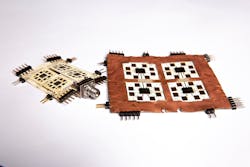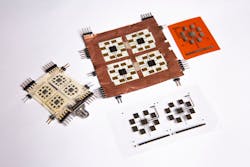Antennas for 5G Networks Could be Built From 3D-Printed Tiles
5G technologies and those that follow will rely on large antenna arrays, which are typically bulky and come only in very limited sizes. This would make the antennas difficult to transport and expensive to customize—unless suitable alternatives are developed.
Fortunately, researchers at Georgia Institute of Technology’s College of Engineering have developed a novel and flexible antenna that addresses the problem: a 3D-printed tile-based modular approach that can be used to quickly build antenna arrays, even electronically steerable versions. The arrays are conformable and can be placed on the surface of devices and objects. The tiled antennas do not degrade when bended or flexed, nor when scaled up by using large number of modular tiles.
In Georgia Tech’s new approach, flexible and 3D-printed manufactured tiles are attached to a flexible underlying layer. Each tile includes an antenna subarray and a beamforming IC. The underlying layer can seamlessly connect the tiles into large antenna arrays and massive multiple-input multiple-outputs (MIMOs), which can be used to put two or more antennas in a single wireless device.
The team built a proof-of-concept, flexible 5×5-cm tile array and wrapped it around a 3.5-cm radius curvature to show it was flexible enough to fit on almost any surface.
The modular tile approach should let tiles of identical sizes be manufactured in large quantities and, once installed, be easy to replace. This will reduce the cost of customization and repairs. Essentially, this approach combines removable elements, modularity, massive scalability, low cost and flexibility.
“The shape and features of each tile scale can be different so that each accommodates different frequency bands and power levels,” says Manos Tentzeris, a professor in Georgia Tech’s School of Electrical and Computer Engineering. “One could have communications capabilities, another sensing capabilities, and another could be an energy-harvesting tile for solar, thermal, or ambient RF energy. The application of the tile framework is not limited to communications.”
“The tile-architecture’s mass scalability makes its applications particularly diverse and virtually ubiquitous,” says Tentzeris, “from structures the size of dams and buildings, to machinery or cars, down to individual health-monitoring wearables. We’re moving in a direction where everything will be covered in some type of a wireless conformal smart skin encompassing electronically steerable antenna arrays of widely diverse sizes.”
The team envisions their tile-based antennas and circuits being used for IIoT, virtual reality, as well as smart manufacturing/Industry 4.0. Another innovative use would be to attaching a tile array to an unmanned aerial vehicle and fly it over an area of low 5G coverage if the is an anticipated surge in the need for broadband capacity. This could be useful in natural disasters or military outbreaks.
The team will be testing their tiles outside the lab on large, real-world structures. They are also working on fabricating much larger, fully inkjet-printed tile arrays with more than 250 elements.

